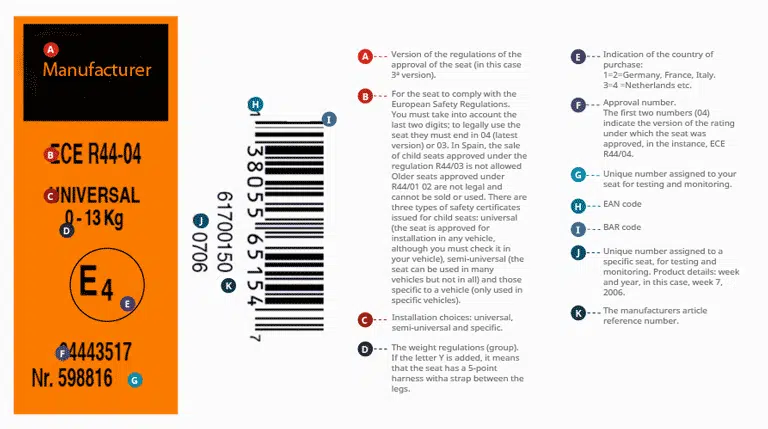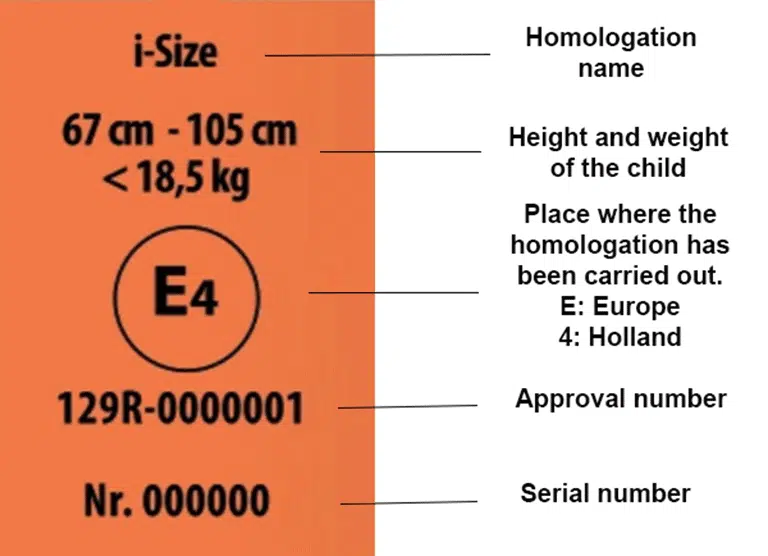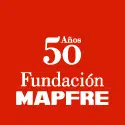Current ECE R44 regulation

New regulations
At the moment there are two coexisting regulations on child restraint systems: ECE R44/04 and ECE R129/03.
The ECE R44 approval standard was adopted in 1982 and has since been revised three times for improvements and adaptations to technical advances. Since spring 2008, child car seats approved under the first two versions of this standard (ECE R44/01 and ECE R44/02) can no longer be used in Europe..In Spain, child car seats approved under ECE R44/03 are also no longer allowed to be on the market.
In addition to the classification in The safest seat section, child seats are classified according to the restraint system used to secure the CRS:
Universal
In all vehicles. The child seat is attached to the vehicle by means of a 3-point seat belt approved in accordance with ECE regulation No. 16. Nevertheless, it is always advisable to check that the child seat and the vehicle seat are “compatible“, i.e. that the child seat can be firmly installed in the vehicle(s) where it is intended to be used.
Universal ISOFIX
Universal ISOFIX child seats must have a third anchor point, called top tether, which must be hooked to the corresponding anchor point located on the rear part of the vehicle’s bodywork. Moreover, the vehicle owner’s manual must state that it is possible to install “universal ISOFIX child seats”.
Semi-universal
These child seats use the vehicle’s seat belt and additional anchor points. An example would be a group 2-3 CRS using additional ISOFIX-type anchor points. These child seats can be used in a wide variety of vehicle models. However, there are some limitations that must be taken into account.
Semi-universal ISOFIX system
This is the case, for example, for some ISOFIX seats whose third anchor point consists of a support leg resting on the floor of the vehicle. Some vehicles have additional space under the floor for storing small objects or luggage and the ISOFIX seat’s support leg may not be able to rest on this storage space as it could give way and collapse during a collision.
Specific for certain vehicle modles
These child seats can only be used in certain vehicle models. The car models in which these child seats can be installed are listed in the vehicle owner’s manual.
The last two digits of the ECE R44/04 standard indicate that the seat has been approved to the fourth version of the standard, which came into force in June 2005.
Approval label
Child car seats approved under ECE R44 must display in a visible place the following approval label, which is the guarantee that the product has passed the required tests and is safe.

Regarding child restraint systems intended for children between 40 cm and 105 cm in height, these shall be referred to as i-Size or integral universal ISOFIX car seatswhen they can be installed in all i-Size approved vehicles, and by default in all vehicles compatible with ISOFIX semi-universal car seats.
They shall be referred to as vehicle-specific ISOFIX car seats when, due to their size, the seats are not compatible with all car models, and therefore a list of vehicles will be provided.
It should be noted that, in terms of safety, an i-Size car seat is not better than a vehicle-specific ISOFIX seat, as they both meet the same safety requirements, but they differ by size. Vehicle-specific ISOFIX seats can be better in terms of space for the child, especially in rear-facing products.
In addition, when the child is secured by means of a safety belt, child car seats shall be referred to as:
- Universal belted
- Vehicle-specific belted
This classification is similar to that of ISOFIX systems, but it is aimed at car seats that are fixed to the vehicle by means of a seat belt.
Child restraint systems intended for children between 100 and 150 cm in height are classified into 4 categories, which follow the same criteria explained here above for seats intended for children between 40 and 105 cm.
- i-Size booster seat,
- Vehicle-specific booster seat,
- Universal belted booster seat,
- Vehicle-specific belted booster seat
What at first sight seems to be a very complex classification is actually very simple. We must only remember two key concepts: if it’s i-Size, the seat has an ISOFIX system and it can be installed in any vehicle; if the seat is vehicle-specific, we must check the list of compatible vehicles or make sure that the seat fits in our vehicle.
i-Size or ISOFIX means that the car seat is installed by means of the ISOFIX system. Belted means that the seat is installed by means of the vehicle’s seat belt.
What does the approval label look like?
An example of i-Size approval label:

IMPORTANT: please bear in mind that a child car seat from the USA, for example, which has been approved according to this country’s legislation, is not legally valid in another country, such as Spain, where approval regulations are different.
However, a child car seat is, generally speaking, as safe in one country as in any other. Therefore, parents travelling with their own child seat must always use it until they are able to obtain a child seat approved under the requirements of the country they have travelled to. The above situation does not arise within Europe, as the ECE R44/04 standard is valid for the whole of the European Union.
